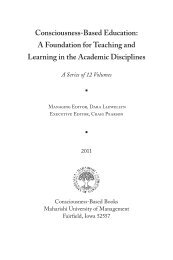The Bhagavad-Gita: A Case Study in Vedic Psychology - Maharishi ...
The Bhagavad-Gita: A Case Study in Vedic Psychology - Maharishi ...
The Bhagavad-Gita: A Case Study in Vedic Psychology - Maharishi ...
Create successful ePaper yourself
Turn your PDF publications into a flip-book with our unique Google optimized e-Paper software.
MODERN SCIENCE AND VEDIC SCIENCE<br />
In this (Yog) no effort is lost and<br />
no obstacle exists. Even a little of<br />
this dharma delivers from great fear.<br />
(II. 40)<br />
In <strong>Maharishi</strong> <strong>Vedic</strong> Science, Sankhya is one section of the Upang aspect of the<br />
<strong>Vedic</strong> literature, one which gives an <strong>in</strong>tellectual description of the full range of reality;<br />
Yog is another Upang which provides systematic procedures to experience the field of<br />
pure consciousness and thereby ga<strong>in</strong> enlightenment. (Upang refers collectively to the<br />
six systems of ga<strong>in</strong><strong>in</strong>g complete knowledge, provid<strong>in</strong>g both <strong>in</strong>tellectual understand<strong>in</strong>g<br />
and direct experience. Please refer to Dillbeck, 1988 for a description of aspects of the<br />
<strong>Vedic</strong> literature <strong>in</strong> <strong>Maharishi</strong> <strong>Vedic</strong> Science.) Lord Krishn tells Arjun that the practice<br />
of Yog (union) will establish his awareness <strong>in</strong> the field of pure consciousness, free<strong>in</strong>g<br />
him from his present state and all potential states of suffer<strong>in</strong>g. Lord Krishn also immediately<br />
po<strong>in</strong>ts out to Arjun that the practice of Yog, to ga<strong>in</strong> the experience of transcendental<br />
consciousness, is easy and effortless because it follows the natural tendency of<br />
evolution (dharma) of the m<strong>in</strong>d. <strong>The</strong> effortless nature of the experience of transcendental<br />
consciousness is discussed <strong>in</strong> detail below.<br />
In describ<strong>in</strong>g the experience of the field of pure consciousness, Lord Krishn <strong>in</strong>structs<br />
Arjun:<br />
... Be without the three gunas,<br />
О Arjun, freed from duality, ever<br />
firm <strong>in</strong> purity, <strong>in</strong>dependent of possessions,<br />
possessed of the Self.<br />
(II.45)<br />
<strong>Maharishi</strong> po<strong>in</strong>ts out that this verse gives three characteristics of the field of pure<br />
consciousness: it is non-dual, it is separate from all objects, and it is one's <strong>in</strong>nermost<br />
"Self." He emphasizes that this verse also describes how to ga<strong>in</strong> the experience of pure<br />
consciousness. In his <strong>Vedic</strong> Science, <strong>Maharishi</strong> (1967) identifies the "three gunas" as<br />
three qualities of activity—creation, ma<strong>in</strong>tenance, and destruction—at the basis of all<br />
manifestation and change <strong>in</strong> objective and subjective nature. Thus, the phrase "Be without<br />
the three gunas" <strong>in</strong>dicates that to ga<strong>in</strong> this experience, one's awareness has only to<br />
be without activity. This is the experience of the fourth state of consciousness,<br />
described by <strong>Maharishi</strong><br />
(Alexander & Boyer, 1989).<br />
<strong>Vedic</strong> <strong>Psychology</strong> as transcendental consciousness<br />
If it is only necessary to "be" to have this experience, one might ask why Arjun has<br />
not had this experience already. Referr<strong>in</strong>g back to the theme of attachment, Lord Krishn<br />
goes on to state that it is the habit of desire which br<strong>in</strong>gs the attention outward through<br />
114

















